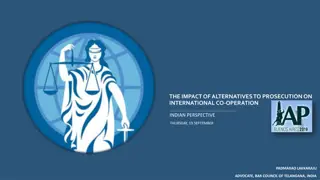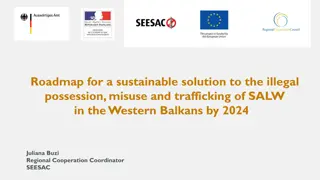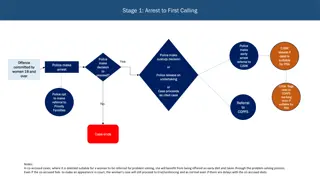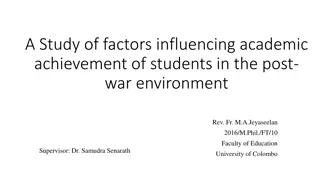Understanding Factors Influencing Prosecution of Children's Testimonies
The research explores the characteristics distinguishing children's testimonies that proceed to prosecution from those that do not. Highlighting the significance of children's statements as evidence in legal proceedings, it delves into prosecution rates, question types used during interviews, and the impact of interviewer experience. With a sample of 46 testimonies analyzed, the study uncovers patterns in prosecution rates and the influence of various factors on legal outcomes.
Download Presentation

Please find below an Image/Link to download the presentation.
The content on the website is provided AS IS for your information and personal use only. It may not be sold, licensed, or shared on other websites without obtaining consent from the author. Download presentation by click this link. If you encounter any issues during the download, it is possible that the publisher has removed the file from their server.
E N D
Presentation Transcript
What characterizes childrens testimonies that proceed to prosecution as compared with those that do not? The Cyprus Journal of Sciences, Vol. 12, 2014 Dr. Marilena Kyriakidou Research Fellow in the Psychology of Violence and Interpersonal Aggression, Coventry University Intelligence Analyst on Children Testimonies, CID Cyprus Police Senior Researcher, NGO Domestic Violence Cyprus ab8061@coventry.ac.uk
Importance of Childrens Testimonies 2/3 of cases only source of evidence (Kyriakidou, 2011) Unambiguous evidence or third testimonies do not usually exist (O Keefe, 2004) Judges and juries rely heavily on testimonials in deciding the outcome of a trial (Porter & Brinke, 2009)
Prosecution Rates 1 to 16 % of all police cases involving children get prosecuted (Sedlak, et al. 2006) unsatisfactory and misleading evidence (Ashworth, 1998; Baldwin & Bedward, 1991) weaknesses often arise during a trial (Leng, 1993). 1/5 in England and Wales (in 1997) proceeded to prosecution (Gallagher & Pease, 2000) less convincing when inappropriate questions have been used (Lindsay et al. 2010)
Question Types Oxburgh et al. 2010; p.53
Interviewers Experience Interviewers experiences did not affect the use of inappropriate questions (Myklebust & Bjorklund, 2006)
Research Questions Prosecution Rates Prosecution Rates Prosecution Rates Prosecution Rates Evidence Inappropriate Questions Appropriate Questions Experience
Sample 46 Testimonies M= 10.11, SD=3.35 3 -16 years old Prosecution rates 27 proceeded to prosecution, 6 did not proceed, 13 still under investigation or unknown Interviewers experience: 22 interviewers had 3 years or less experience in interviewing children, 24 interviewers had 4 to 6 years of experience in interviewing children.
Research Questions Prosecution Rates Prosecution Rates Prosecution Rates Prosecution Rates U=34, p =.028, r=.38 U=71.5, p=.657. r= .07 Inappropriate Questions U=71, p= .639, r= .08 U=68, p=.535, r= .2 Evidence Appropriate Questions Experience
Conclusions Number of evidence the most significant factor influencing whether a case was prosecuted Informative testimonies (Wood & Garven, 2000) Not consider whether evidence came from inappropriate questions inaccurate information Base their decision mostly on the amount and not on the quality of evidence Efficiency of police department report that may produce
Implications Improve police records Future study after improvement of police records Ensure quantity and quality of evidence Intelligence analysts help on providing an opinion on the quality of evidence elicited
Thank you Dr. Marilena Kyriakidou ab8061@coventry.ac.uk























